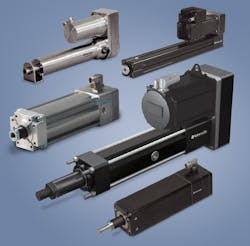Comparing Electric and Fluid-Power Actuators
Content has been updated as of Oct. 13, 2021.
Electric rod-actuators are replacing fluid power actuators for many high-force applications throughout industry. Tasks once limited to hydraulic and pneumatic cylinders such as pressing, holding, lifting and spot welding are now handled by electric actuators, in part because of their lower life-cycle costs. What’s more, electric actuators’ speed, accuracy and flexibility can increase production and make machines more flexible and adaptable.
Here’s a look at some of the advantages electric actuators bring to designers and engineers.
Energy Efficiency
Electric actuators typically operate in the 75 to 80% efficiency range. In comparison, hydraulics typically range from 40 to 55% in efficiency and pneumatics have efficiencies in the 10 to 25% range. Many factors determine the efficiencies of fluid-power systems, including temperature, pressure, compressor designs, seal integrity and system leaks.
A significant factor in electric actuators’ efficiencies is that they only consume current in the drive motor when it is required. When at rest, electric actuators require little, or no (with a brake), current to hold position. Fluid-power actuators, on the other hand, always need pressurized fluid, which is an inefficient use of power.
Quiet and Compact
Not only do electric actuators save energy, but they also save overall space, which can be useful on crowded factory floors. Hydraulic systems require a cylinder, a power unit to provide oil pressure, control valves, filters and other ancillary components. Electric systems only require the actuator and motor itself and a relatively small control cabinet for the drive, which can usually be conveniently located near the point of use.
Power units running fluid cylinders are typically noisy, a nuisance and have the potential to damage the hearing of anyone working or even walking near them. Electric actuators are significantly quieter.
Accuracy and Repeatability
Although standard fluid actuators are good for end-to-end stroking applications, mid-stroke positioning is more complicated, requiring a control valve and operator assistance. More advanced servo hydraulic controls can give fluid systems greater precision and repeatability, but at a considerable increase in cost and complexity. Electric actuators offer infinite positioning as a standard, are much less complex and, once programmed, require little intervention or maintenance to remain accurate and consistent.
Clean and Green
Leaks from hydraulic systems can create hazardous messes on factory floors. In addition, hydraulic leaks can contaminate key processes; the environment (when outdoors); and products such as food, pharmaceuticals and medical devices. In pneumatic systems, air leaks create unwanted noise, questionable air quality, and wasted energy. Electric actuators have none of these drawbacks.
For example, a lumber-processing equipment company needed to replace a hydraulic cylinder in a log-cutting application to eliminate the potential of hydraulic fluid leaks into the environment. The company chose to go with a Tolomatic electric ball-screw rod actuator with a 42-inch stroke to move the saw blade. It has an IP67 rating, indicating the actuator was built to be protected from splashing water and debris. The actuator was also lubricated with a high/low-temperature grease for consistent performance in all weather conditions.
Minimal Maintenance
Properly sized electric actuators typically require little or no maintenance. In demanding performance applications, electric actuators may need to be re-greased, but it is usually an infrequent, simple and low-cost procedure. Fluid power devices, while typically rugged and easy to deploy, require considerable maintenance as a tradeoff. Air and oil maintenance, for example, are needed to prevent humidity and contaminants from prematurely destroying seals and other system components.
For example, a steel mill recently switched from hydraulics to electric actuators to replace maintenance-intense hydraulic cylinders. But the mill still needed powerful actuators. Pulling hot castings out of the molds required about 15,000 lb of force (66 kN), and whenever castings were left to cool in the molds, it took a peak of about 40,000 lbf (177 kN) to break the casting out of the mold.
The plant managers eventually chose two rod-style electric actuators from Tolomatic and high-capacity roller-screws to reduce maintenance and meet peak thrust requirements. The actuators could deliver the force necessary and carried IP65 ratings which maximized their life in the hot, dirty foundry.
Improve Productivity
Electric actuators can improve overall productivity better than fluid cylinders in many applications. For example, an electric rod actuator might need to go out six inches and return for set-up purposes, and then only travel three inches back and forth for production runs. Fluid actuators, on the other hand, have poor positioning capabilities and can only move the entire six inches out and back, wasting time and efficiency on each cycle. Electric actuators are fully programmable and can be set up to do both six and three-inch runs, thereby saving time and increasing throughput.
In one example, an OEM that made a variety of automotive wheel-bearings and wanted to replace the hydraulic cylinders in the process to improve control and reduce energy consumption, as well as eliminating hydraulic fluid leaks. The hydraulic cylinders were configured to handle different sized wheels, and this meant the operator had to make several adjustments every time a different wheel was going to be sent down the line. This led to lost production time and, sometimes, additional rework.
The OEM switched to roller screws with a servo-controlled electric actuator that could provide up to 17,000 lbf of consistent, repeatable force. The servo controls let the company create quick and easy changeover control program procedures for changing over to wheels of any size quickly with the push of a button.
Low Life-Cycle Costs
Electric actuator systems are twice as efficient as hydraulic systems, but they can have higher upfront costs. However, the costs over the actuator’s life are substantially less if the increased performance, system flexibility, lower maintenance, process improvements and lower utility costs are factored in.
Andrew Zaske is vice president of sales and marketing at Tolomatic Inc.
This article appeared in Machine Design.
About the Author
Andrew Zaske
Vice President of Sales and Marketing, Tolomatic

Leaders relevant to this article:





